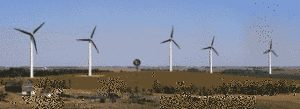Endangered bats may pose little threat to wind developers

By Tom Steward │Watchdog Minnesota Bureau
Nothing strikes fear into developers and property owners more than a new critter on the federal list of endangered species.
Case in point: The northern long-eared bat, found in 39 states. The U.S. Fish and Wildlife Service will probably place it on the list in April, and the logging industry is worried.
“The economic loss to the entire state of Michigan would be devastating, if timber harvesting were to be restricted to the winter months in their habitat area,” said Brenda Owen, executive director of the Michigan Association of Timbermen. “This is not a viable solution to the bat’s decline, and it’s never a solution that the Timbermen would stand by and let happen.”
Opponents of wind energy farms view the probable endangered status as another tool for challenging wind projects in environmentally sensitive areas.
Wind turbines kill an estimated 600,000 or more bats a year, a University of Colorado study shows. That includes an unknown number of endangered northern long-eared bats.
WHERE THERE’S WIND, THERE’S A WAY: USFWS officials acknowledge that wind turbines pose a threat to endangered bats, while working to find a way to keep turbines turning.
“Bats are killed in large numbers, and long-eared bats are not exempt from that,” said Kristi Rosenquist, an activist who led a successful effort to stop a Minnesota wind farm. “There’s more bats in farm fields than the wind industry thinks. And in the rare projects that have had post-construction studies, the number of dead bats has been way higher than predicted ahead of time.”
Fish and Wildlife ranks wind energy development as a top threat to the long-eared bat, along with habitat loss, climate change and contaminants.
“While wind power has many advantages over other sources of energy, if not sited and operated with thoughtful planning, the rotating turbines kill birds and bats and construction of the facilities can destroy natural areas that provide habitat,” the USFWS website says.
At the same time, a deadly fungus threatens the northern long-eared bat with “white nose syndrome,” killing off 99 percent of the species in some Eastern states. Since 2006, the incurable disease has wiped out an estimated 5.5 million of the cave-hibernating creatures.
But federal authorities appear to be taking a kinder, gentler approach with the wind industry, which runs counter to Fish and Wildlife’s perceived hard-nosed role when it comes to threatened species.
“We’re working with the American Wind Energy Association right now on a fairly large, multi-state conservation plan for wind energy for Indiana bats, which is an endangered species, and northern long-eared bats may be considered as part of that,” said Georgia Parham, a USFWS public affairs specialist. “That is something that we have available under the Endangered Species Act to deal with instances, where a listed species might be killed or harmed, during an otherwise legal activity.”
Under the plan, the agency issues an “incidental take permit” as part of a mitigation strategy that allows recipients to legally kill endangered bats without prosecution. Seven wind farms have posted federally approved Habitat Conservation Plans for the endangered Indiana bat that effectively protect investors for up to 50 years on one project.
“No one’s allowed to kill a species without a permit, but beyond that there are lots and lots of ways to work with all sorts of projects, and we do that every day in the U.S. Fish and Wildlife Service,” said Parham. “So we’re expecting to approach this the way we’re approaching other listed species.”
The Minnesota Department of Natural Resources reports no record to date of turbines killing northern long-eared bats on the northwestern edge of the bat’s range in the state.
“The DNR is concerned about the impact of wind turbines on bats in general, and have partnered with the Minnesota Department of Commerce to study these impacts and ways to minimize them,” Rich Baker, Minnesota endangered species coordinator, said in an email.
While the creature tends to summer in Northern forests away from most wind farms, opponents of a proposed 20 megawatt wind farm in Sibley County hope to make northern long-eared bats an issue. The developer did not reply to a Watchdog Minnesota Bureau inquiry.
“We sent in a complaint about that endangered bat and they (the developers) said we’re doing a study,” said Barb Wenninger, a Cornish Township resident who filed a Freedom of Information Act request with USFWS. “But no one out here has seen anybody in the area. And there’s no bat towers up. Nothing, nothing’s going on.”
This summer, the developer of two proposed Stearns County wind facilities with up to 41 turbines undertook a second pre-construction survey for northern long-eared bats based on new federal guidelines.
“The Avian and Bat Protection Plan lays out measures the project has taken and will take to avoid and minimize our impacts on birds and bats — and its implementation is part of our site permit with the state,” said Lindsay Smith, marketing and public relations associate for Geronimo Energy. “… The results of our study concluded that there are no northern long-eared Bats in the Black Oak Wind Farm project footprint.”
In a September 29 letter, the DNR recommended Geronimo Energy find alternative locations for several planned turbines “due to proximity to avian and bat habitat and possible increase in collision risk.”







